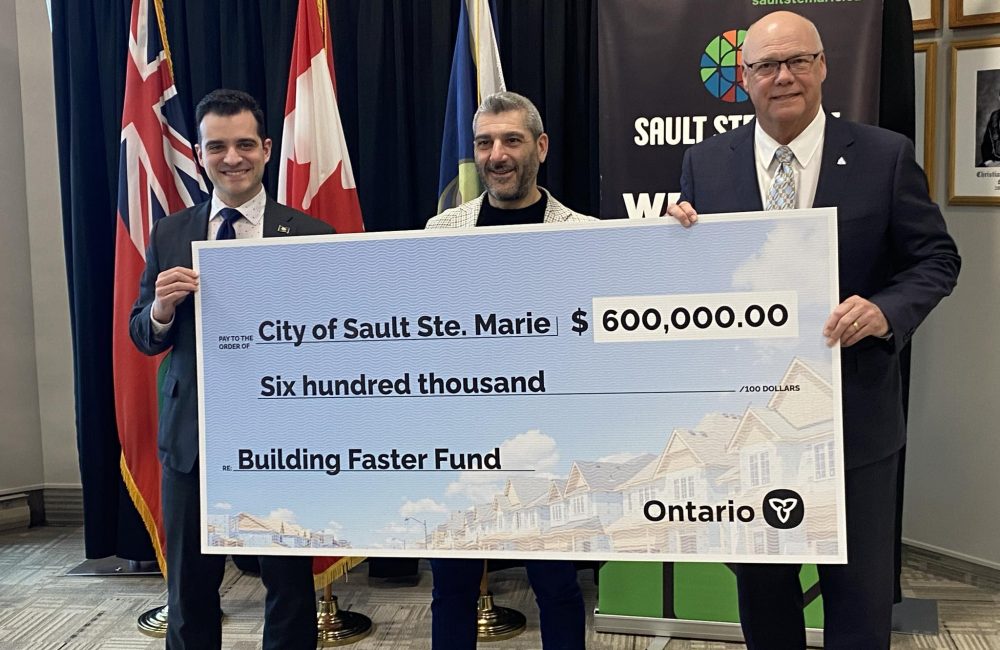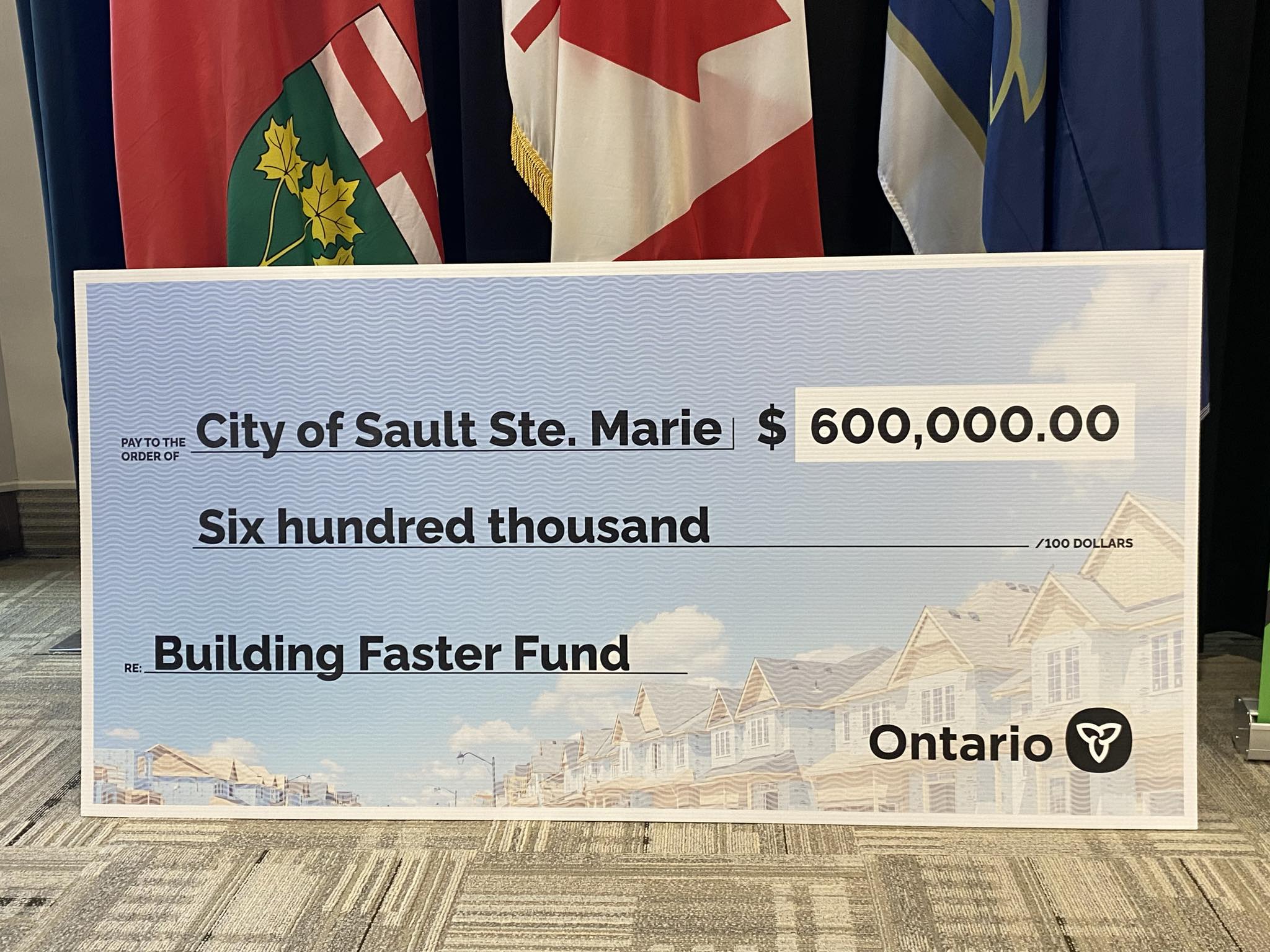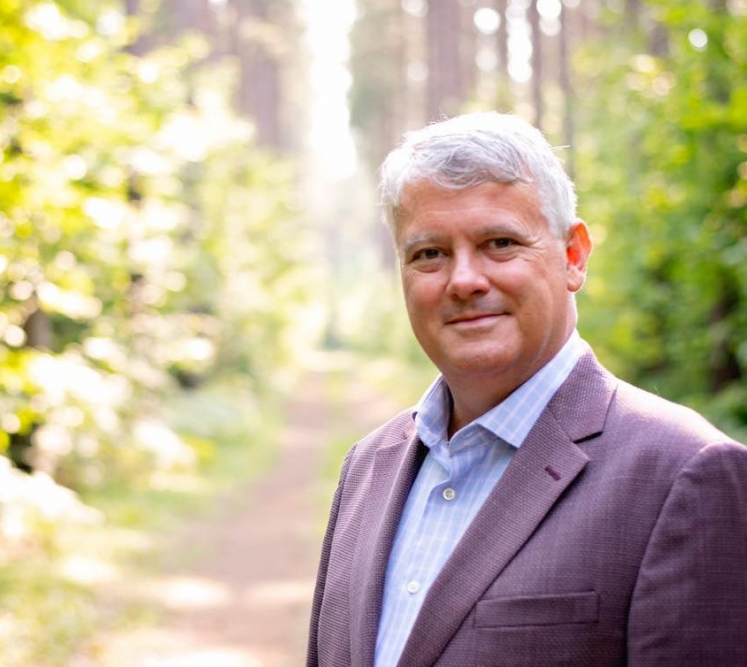By exceeding its provincially-assigned housing target for 2023, Sault Mayor Matthew Shoemaker and the City of Sault Ste. Marie received $600,000 from the province Friday.
It was a windfall, a bonus for the City’s success in the first year of the Ford government’s Building Faster Fund (BFF), a program offering municipalities an incentive to build new homes and housing units and take a major bite out of Ontario’s housing crunch.
The funds will be poured into infrastructure, a key and sometimes stumbling block to new development.
The Mayor, who was joined at yesterday’s funding announcement at the Civic Centre by Associate Housing Minister Rob Flack and Sault MPP Ross Romano, is determined to maximize the program’s benefits by exceeding its targets every year.
He was clearly elated to receive the funds Friday. He says while there is still significant work to be done, the Sault is already off to a great start this year.

“We’re off to a strong start in 2024,” said Shoemaker. “Building stats for the year are well ahead of last year’s pace, with the value of permits issued between January and February exceeding $40 million, already.”
Shoemaker said he expects to see some projects on Pine Street, the
re-development of the Cara House site and the completion and occupation of the Legion building on Great Northern Road.
The Mayor says its “paramount” municipal, provincial and federal governments continue to work together on infrastructure and housing development. He said the City will continue to tap every available source at its disposal to reach the long-term goal of 1500 new housing units by 2031.
The Sault’s 2023 target was 110 units, and the city finished the year with 213, exceeding the target by 194 per cent.
Flack has been travelling across the north this week rewarding communities for meeting and exceeding their housing targets. He was in Thunder Bay Thursday and Sudbury Friday morning. He praised the efforts in Northern centres for taking advantage of the BFF program.
“The north has certainly exceeded expectations and done a great job,” said Flack. “There’s many communities south of there that could take your good examples and hopefully meet or exceed expectations.”
Twenty-two municipalities fell short of their targets for 2023. Red tape was one culprit, said Flack, while other communities may have had numerous permits, but lacked starts.
“I’ve talked to a lot of Mayors and councils that didn’t qualify, and it’s like any program, they’re disappointed. We measured the same across the province. As I remind them, if at first you don’t succeed, try, try again.”
Flack says municipalities that didn’t meet their target in ’23 have the opportunities to do so this year and in 2025.
The Ford government has placed major emphasis on housing, Flack said. Purpose-built rentals are up by almost 27 per cent in the past year. He said more success is needed in what he called the “middle” strata of attainable housing, those who make too much money to qualify for affordable housing and those unable to get a mortgage because they can’t make a downpayment, or cash flow an existing mortgage.
“We’re working hard to develop opportunities in that missing middle,” said Flack.
Shoemaker says the City did whatever it could to facilitate building in the past year.
‘Densification’ is a priority for the City and encouraged by the province. Build bigger and/or higher, to maximize available lot space.
Shoemaker called council’s recent amendment to the City’s zoning by-law encompassing residential development regulations the most significant change since the implementation of the zoning by-law itself.
“Whether it was re-zonings, whether it was approval of tax increment grants where if you agree to build something your taxes are phased-in over a number of years…we have done everything possible to ensure that anyone who wants to build is building as much and as many units as they can put on a piece of property,” said the Mayor.
A study conducted by city staff found the Sault will need about 3,100 new housing units by 2036 to help meet the demands of a forecast population growth of 8,400 over the next 12 years.
The City has plenty of available land for future housing development, said Shoemaker. He called the available acreage significant.
“We’ve got lots of empty property right here in the downtown core that I think would fit well with any proposal to develop them,” said Shoemaker.
He said it’s universally accepted downtown development “has to have people in the core” for it to work. Building more units downtown, he added, will be one of the key components of the City’s housing plan going forward.






